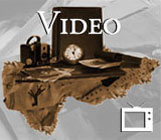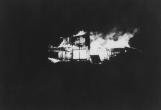1
Danger!Living near the oil wells had its benefits as well as its dangers. Gas was cheap and easy to access. People not only heated their homes with gas, they also heated their outhouses. The gas pressure was difficult to control and a lit cigarette or ignited stove could easily cause a fire or small explosion. There was no fire department and so it was up to the families to control any fires. The nearest hospital was in High River, Alberta, and one High River resident who delivered newspapers remembers seeing many burn victims in the wards.
The air was thick with the smell of sour gas. Gas from the wells was passed through separators. Producers kept and sold the condensate while flaring off the by-product gas. There was practically a flare in every back yard, creating enough light for people to read a newspaper at night. Grass would stay green year round and migrating birds wintered in the flare's warmth. The flares were loud, and gas production created a vibration strong enough to knock store merchandise to the floor. Shopkeepers had to put strings across their shelves to keep everything in place. There was also the danger that a well could catch fire and burn out of control.
Older derricks were made of wood and would burn very easily. In situations like this, special control experts were brought in to blow away the flames with explosives.
2
Was Little Chicago a dangerous town to grow up in?Filmed in 2008
Little Chicago / Royalties, Alberta, Canada
 Credits:
Credits:Museum of the Highwood
3
Little Chicago: "Famous for dogs, kids, and gas heated 'two holers'"Circa 1930s
Little Chicago / Royalties, Alberta, Canada
 Credits:
Credits:Museum of the Highwood
4
"It was during the winter so many fires occurred. Because there was a minimum market for gas, the dry gas surplus from the wells flowed unregulated directly through pipes to burn off as roaring flares. Gas was tapped illegally from the pipes. It was free and provided our homes with warmth and fuel for cooking.Most back yards contained an old oil drum with both ends cut. A gas jet on the bottom of the drum, when ignited, became a constant fire, which in turn burned all our refuse. Our un-insulated homes were warm, however because gas fittings from the pipes were attached by inexperienced novices, one would never know when an explosion might occur. As a result, my mother would, before retiring at night, place a shopping bag containing clothing next to the kitchen door.
How often we heard the ring of the church bell followed by a voice shouting "fire." An endless line of volunteers formed a human line from the water shed to the burning structure. Pails of water exchanged hands to finally reach those standing on treacherous ladders to empty the liquid onto the scorching flames. Neighboring roofs were moistened to extinguish flying sparks. The sparks erupting from the burning home flickered as fireflies glowing in the dark - some burning themselves out in the sky - others traveling to nearby roofs.
Despite all efforts, within hours total destruction was evident. The remains of a mattress spring, sink, stovepipes, stove, and ash burned wooden posts were reminders of the helpless battles. Throughout the ordeal, my sister and I held firmly to my mother's skirt as her hands clutched the brown shopping bag full of clothes. The homeless family found refuge with neighbors. Following the tragedy, the community held a whist drive, a dance, and several benefits to provide the distressed family with sufficient funds to build a new dwelling. What a wonderful and caring support system."
- Helen (Fishman) Goldenberg
5
The citizens of Little Chicago got used to the sight of smoke and flamesCirca 1930s
Little Chicago / Royalties, Alberta, Canada
 Credits:
Credits:Museum of the Highwood
6
A Little Chicago business on fireCirca 1930s
Little Chicago / Royalties, Alberta, Canada
 Credits:
Credits:Museum of the Highwood
7
"One day Hugh (Jackson) and I were working in the Westflank lease just north of Royalties and heard a big bang from the south and wondered 'who blew up today'?"- W.H. Watt, In The Light of the Flares
8
A very large gas flare adjacent to the Royal Crest Well and derrickCirca 1935
Little Chicago / Royalties, Alberta, Canada
 Credits:
Credits:Museum of the Highwood, 987.044.803